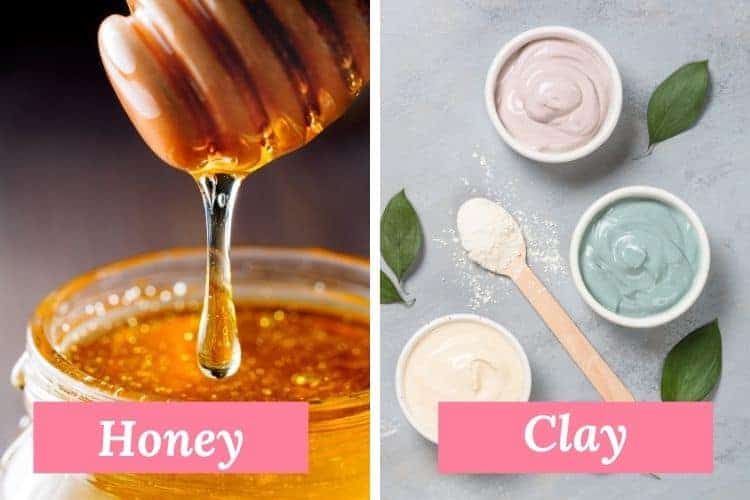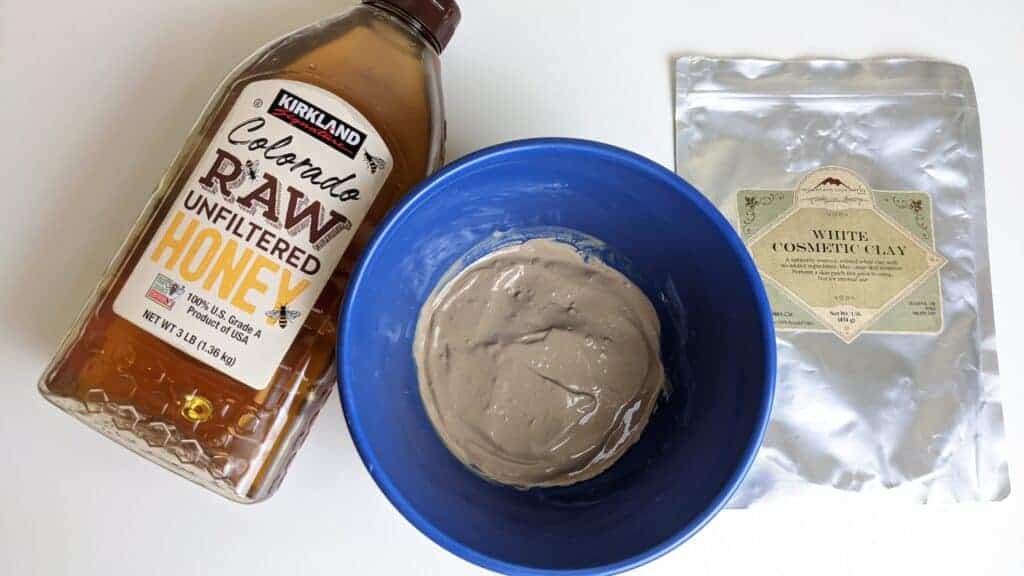
Honey and clay are simple yet effective natural remedies that can help with various skin conditions, including acne. But when comparing a honey mask vs clay mask, is one better than the other?
The main difference between a honey mask and a clay mask is that the honey mask is hydrating and antimicrobial, while the clay mask is detoxifying. Despite these differences, both masks also share some similar benefits. When used correctly, they can help to restore balance to the skin.
To help you get a better understanding of what these masks have to offer, this article is going to cover:
- The benefits of honey masks and clay masks.
- How and when to use them in your skincare routine.
- Some DIY recipes you can use at home as well as recommendations for brands to purchase from.
Note: this post contains some affiliate links and I earn a commission (at no additional cost to you) if you use them to make a purchase.
BENEFITS OF USING A HONEY MASK ON YOUR FACE
Honey has a diverse nutritional profile that consists of (1, 2):
- Water.
- Sugars: primarily fructose.
- Inhibine: a natural antibiotic.
- Vitamins: this includes ascorbic acid (vitamin C) and B-vitamins (B2, B3, B5).
- Minerals: this includes calcium, copper, iron, magnesium, zinc and others.
- Proteins: small amounts.
- Phenol antioxidants
- Other micronutrients
All of these ingredients work together to give honey its anti-inflammatory, antibacterial and antiseptic properties. As a result, regular use of a honey face mask can be helpful for:
- Soothing Inflamed skin: whether we’re talking acne, eczema or psoriasis, regular use of honey can help to soothe the underlying inflammation associated with these conditions.
- Supporting skin renewal: some research indicates that honey is very effective at speeding up wound healing (source). This suggests that honey is able to support cell turnover (which is a plus whether you’re trying to clear acne or achieve a healthier, more even appearance).
- Hydrating the skin: no matter your skin type, hydration is essential for a healthy glow. Honey is extremely helpful for this because it contains water and it is a humectant (i.e. it draws moisture to the skin).
BENEFITS OF CLAY MASKS FOR YOUR SKIN

Clays are rich in minerals that make it a powerful, natural detoxifier. Although the exact composition of each type of clay varies from one region to another, some of the minerals that are found in clay include (3, 4):
- Magnesium
- Calcium
- Iron
- Copper
So whether your pores are clogged by dirt, toxins or excess oil, regular use of clay masks can help you to remove all of that gunk.
Overall, clay masks are:
- Antiseptic.
- Antibacterial.
- Natural exfoliants that support skin renewal.
- Unclogging and tightening pores.
| Honey Mask | Clay Mask | |
|---|---|---|
| Detoxifying | ✓ | |
| Hydrating | ✓ | |
| Antiseptic | ✓ | ✓ |
| Antibacterial | ✓ | ✓ |
| Anti-inflammatory | ✓ | |
| Contains minerals | ✓ | ✓ |
| Contains vitamins | ✓ | |
| Soothes inflamed skin | ✓ | |
| Supports skin renewal | ✓ | ✓ |
HONEY MASK VS CLAY MASK: FREQUENCY OF USE AND BEST TYPES
A honey mask can be used daily, and if you’d like, even twice a day (for severe acne). As for the type of honey to use, make sure that it’s raw, unpasteurized honey. This type of honey still has its nutrients intact.
Now, if you’ve probably heard that manuka honey and you’re wondering if you should use it on your skin. Here are my thoughts on this:
- If you’re in Australia or New Zealand where manuka honey comes from, feel free to use it.
- If you’re in another part of the world, go with whatever honey is local to your region.
- Manuka honey is just one of the hundreds (maybe even thousands) of honeys that exist in the world. Each type of honey has medicinal properties that result from the type of flowers that the bees in that area pollinate.
- Manuka honey isn’t the only “amazing” honey that’s out there. It just happens to be the one that is being heavily marketed these days.
Now, as for clay masks it’s best to use them just 1 to 3 times a week (depending on your skin type. More on that later). In terms of types of clay, there are quite a few to choose from, including:
- French Green Clay and Bentonite clay: very absorbent and drying. Best for oily and acne-prone skin.
- Rhassoul clay: moderately absorbent. Can be used on oily, acne-prone, normal or combination skin.
- Kaolin clay: this is the least drying of all the clays. If you have dry skin, this is the only one to try. This clay comes in various colors including white and pink. For more tips on how to use this clay, plus a basic recipe you can use, read this article on how to make a kaolin clay mask for dry skin.
| Honey Mask | Clay Mask |
|---|---|
| Use daily (up to twice a day for severe acne) | Use 1 to 3 times a week |
| Use raw/unpasteurized only | Oily + acne-prone skin: french green clay, bentonite clay, rhassoul clay, kaolin clay Normal + combination skin: rhassoul clay, kaolin clay Dry or sensitive skin: kaolin clay |
HOW TO MAKE HONEY AND CLAY MASKS FOR YOUR SKINCARE ROUTINE

DIY Honey and Kaolin Blemish Fighter
Even though you can make separate honey and clay masks, combining both ingredients makes it easier for you to get the best of both worlds!
This recipe makes enough for face and body. So, if you have back or butt acne, use the leftover mask on your body and enjoy the full body pampering session!
Ingredients
2 tbsp water
2 tsp raw honey
4 tbsp kaolin clay
Instructions
1. Add water and honey into a bowl. Stir to combine.
2. Add in 2 tbsp of the clay. Mix until well combined.
3. Add in the remaining clay and mix well. NOTE: the final mixture won’t be perfectly smooth (as you can see in the image above). Don’t worry about this because those tiny clumps melt away as you apply the mask.
4. Apply the mask to clean skin.
5. Allow to sit for 5 to 10 minutes.
6. Rinse off with warm water.
DIY Honey Mask Recipe
Ingredients
1 tsp honey
A few drops of water (just enough water to make the honey fluid and less sticky).
Instructions
1. Mix the ingredients in a small bowl.
2. Apply the mixture to your face using the tips of your fingers or a makeup brush.
3. Allow to sit for 10 to 15 minutes.
4. Rinse off with warm water.
DIY Bentonite Clay Mask Recipe
Our skin has a moderately acidic pH (4.7 – 5.5), while bentonite clay is alkaline with a pH of 9 (source). Therefore when making a bentonite mask, it’s helpful to use an acidic liquid like apple cider vinegar (pH between 2 and 3). The resulting mask will have a pH that is closer to what the skin prefers.
Mixing bentonite clay with vinegar also ensures that the resulting mask is smooth. If you try to make the mask with plain water you end up with chunks of clay that don’t spread onto the face well.
Ingredients
Equal parts apple cider vinegar and bentonite clay (here’s the one I like on Amazon)
Instructions
1. Combine the clay and ACV in a non-metallic bowl.
2. You will notice some fizzing when the two substances come into contact.
3. Mix with a non-metallic spoon (or spatula) until smooth.
4. Apply the mask to a clean face.
5. Allow to sit for about 7 minutes (the mask shouldn’t completely dry out).
6. Rinse off with warm water.
DIY Rhassoul Clay Mask Recipe
Rhassoul’s pH is in the range of 6.9 – 7.5. So it also benefits from being mixed with apple cider vinegar (or even, aloe vera juice, which is also acidic).
Ingredients
2 tbsp rhassoul clay
1.5 tsp ACV
1.5 tsp water
Instructions
1. Combine the ingredients in a non-metallic bowl. Mix well until smooth using a non-metallic spoon or spatula.
2. Apply to freshly cleaned skin.
3. Allow to sit for about 7 minutes.
4. Rinse off with warm water
DIY Kaolin Clay Mask Recipe
Kaolin clay has a pH of about 4, so you can mix it with distilled water only.
Ingredients
2 tbsp kaolin clay
1.5 tsp ACV
1.5 tsp water
Instructions
1. Combine the ingredients in a non-metallic bowl. Mix well until smooth using a non-metallic spoon or spatula.
2. Apply to freshly cleaned skin.
3. Allow to sit for about 7 minutes.
4. Rinse off with warm water
GENERAL TIPS FOR USING A HONEY OR CLAY MASK
Whether you choose to use a honey mask, clay mask or both, here are some general tips to help you get the best results from:
- Always apply your mask after cleansing, exfoliating and toning your face.
- Follow up your mask with a moisturizer.
- If you have acne and oily skin, use a bentonite clay mask 2 to 3 times a week.
- If you have dry or sensitive skin, try a kaolin clay mask once a week.
- Don’t allow the clay mask to completely dry up and harden completely. If that happens then all it’s doing is removing more moisture and oil from your skin (you still need your natural sebum!).
BEST CLAY MASKS FOR ACNE-PRONE AND OILY SKIN
1. Aztec Secret Bentonite Clay
This is definitely one of the most popular bentonite clays on the web! There’s not much to say about this one except to say except that it does not disappoint.
Get yourself a jar here on Amazon and see for yourself why this particular brand has been a staple for years.
2. S.W. Basics Hibiscus Mask
Made from just three ingredients – French green clay, hibiscus powder and lavender powder – this mask is ideal for fighting off acne while also soothing the skin.
Let’s have a quick look at what each ingredients brings to the table:
- French Green Clay: detoxifies the skin, shrinks pores and helps to clear acne.
- Hibiscus Powder: natural source of exfoliating AHAs (alpha hydroxy acids), rich in mucilage (a natural moisturizer) and rich in antioxidants (source).
- Lavender Powder: anti-inflammatory, antimicrobial, soothing to inflamed skin.
You can get this SW Basics hibiscus mask here on their website.
3. Kaolin and Rhassoul Clay from Mountain Rose Herbs
For all other clays I like to buy them mainly from Mountain Rose Herbs. They’re a reputable supplier of high quality clays, herbs and basically everything related to natural skincare.
Here’s their kaolin clay aka white cosmetic clay, which I used for one of the recipes earlier in this article. You can search their website for all the other clays.
CONCLUSION
Honey’s hydrating and nourishing properties are a soothing complement to clay’s detoxifying properties. Combine them in your skincare routine and you’ll be well on your way to supple, glowing and blemish-free skin.
You Might Also Enjoy:
How Do You Make a Bentonite Clay Mask Smooth? Step-by-Step Guide (with Recipes and Visuals)
What to Mix with Bentonite Clay For A Face Mask: 13 Skin-Loving Ingredients
Honey vs Aloe Vera for Face: Benefits, Best Ways To Use and Recipes
What To Do Before and After Using A Clay Mask On Face: Step by Step Guide

